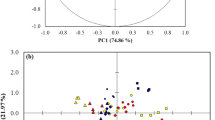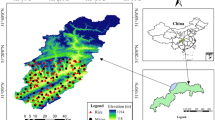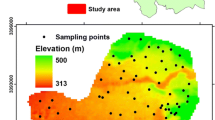Abstract
Accurate evaluation of soil productivity has been a long-standing challenge. Although numerous models for productivity assessment exist, most are cumbersome to use and require substantial parameter inputs. We developed a new empirical soil productivity model based on field investigations of soil erosion, soil physicochemical properties, and crop yields in the dry-hot valleys (DHVs) in China. We found that soil pH, and organic matter and available potassium contents significantly affected crop yields under eroded conditions of the DHVs. Moreover, available potassium content was the key factor affecting soil productivity. We then modified an existing soil productivity model by adding the following parameters: contents of effective water, potassium, organic matter, and clay, soil pH, and root weighting factor. The modified soil productivity model explained 63.5% of the crop yield. We concluded that the new model was simple, realistic, and exhibited strong predictability. In addition to providing an accurate assessment of soil productivity, our model could potentially be applied as a soil module in comprehensive crop models.
Similar content being viewed by others
References
Amundson R, Berhe AA, Hopmans JW, et al. (2015) Soil and human security in the 21st century. Science 384 (6235): 1261071. DOI: 10.1126/science.1261071
Bauer A, Black AL (1994) Quantification of soil organic matter content on soil productivity. Soil Science 58: 185–193. DOI: 10.2136/sssaj1994.03615995005800010027x
Chai ZX (1987) Soil erosion in karst area of Guangxi Autonomous Region. Journal of Mountain Research 7 (4): 255–259. (In Chinese)
De Paepe JL, Alvarez R (2013) Development of a regional soil productivity index using an artificial neural network approach. Agronomy Journal 105 (6): 1803–1813. DOI: 10.2134/agronj2013.0070
Duan XW, Rong L, Zhang GL, et al. (2015) Soil productivity in the Yunnan province: Spatial distribution and sustainable utilization. Soil and Tillage Research 147: 10–19. DOI: 10.1016/j.still.2014.11.005
Duan XW, Xie Y, Feng YJ, et al. (2009) Study on the method of soil productivity assessment in black soil region of northeast China. Agricultural Sciences in China 8 (4): 472–481. DOI: 10.1016/S1671-2927(08)60234-5
Duan XW, Xie Y, Ou TH, et al. (2011) Effects of soil erosion on long-term soil productivity in the black soil region of northeastern China. Catena 87 (2): 268–275. DOI: 10.1016/j.catena.2011.06.012
Duan XW, Liu B, Gu ZJ, et al. (2016) Quantifying soil erosion effects on soil productivity in the dry-hot valley, southwestern China. Environmental Earth Sciences 75 (16): 1164. DOI: 10.1007/s12665-016-5986-6
Fenton TE, Duncan ER, Shrader WD, et al. (1971) Productivity levels of some Iowa soils. Iowa Agriculture and Home Economics, Special Report, No. 66.
Gale MR, Grigal DF, Harding RB (1991) Soil Productivity Index: Predictions of site quality for White Spruce plantations. Soil Science Society of America Journal 55 (6): 1701–1708. DOI: 10.2136/sssaj1991.03615995005500060033x
Gantzer CJ, McCarty TR (1987) Predicting corn yield on a claypan soil using a productivity index. American Society of Agricultural and Biological Engineers 30: 1347–1352. DOI: 10.13031/2013.30569
Larson WE, Pierce FJ, Dowdy RH (1983) The threat of soil erosion to long-term crop production. Science 219: 458–465.
Leng SY (1992) Research on the potential agricultural productivity of China with the help of GIS. Journal of Natural Resources 7 (1): 72–79. (In Chinese). DOI:10.11849/zrzyxb. 1992.01.009
Li GL (2007) Study on the decline process and instauration path of land productivity on the sloping land in the Southern Loess Plateau. Agricultural Research in the Arid Areas 25 (1): 6–10. (In Chinese) DOI: 10.3321/j.issn:1000-7601.2007.01.002
Ling RF (1973) A Probability Theory of Cluster Analysis. Journal of the American Statistical Association 63 (341): 159–164. DOI:10.1080/01621459.1973.10481356
Liu GS (1996) Soil physical and chemical analysis and profile description. China Standards Press. (In Chinese)
Lobo D, Lozano Z, Delgado F (2005) Water erosion risk assessment and impact on productivity of a Venezuelan soil. Catena 64 (2): 297–306. DOI: 10.1016/j.catena.2005.08.011
Lu RK (1998) Principle of soil-plant nutrition and fertilizer. Chemical industry press, Beijing. pp 46–47. (In Chinese)
Martín JAR, Arias ML, Corbi JMG (2006) Heavy metals contents in agricultural top soils in the Ebro basin (Spain). Application of the multivariate geoestatistical methods to study spatial variations. Environmental pollution 144 (3): 1001–1012. DOI: 10.1016/j.envpol.2006.01.045
Mueller L, Schindler U, Mirschel W, et al. (2010) Assessing the productivity function of soils. A review. Agronnomy for Sustainable Development 30: 601–614. DOI: 10.1007/978-94-007-0394-0_33
Mulengera MK, Payton RW (1999) Modification of the productivity index model. Soil and Tillage Research 52: 11–19. DOI: 10.1016/S0167-1987(99)00022-7
Myers DB, Kitchen NR, Sudduth KA, et al. (2000) Estimation of a soil productivity index on claypan soils using soil electrical conductivity. Proceedings of the 5th International Conference on Precision Agriculture, Bloomington, Minnesota, USA.
National Soil Survey Office (1998) Soils of China. China Agriculture Press, Beijing. (In Chinese)
Neil LL (1979) An Evaluation of Soil Productivity Based on Root Growth and Water Depletion. University of Missouri. Columbia.
Oldeman LR (1994) The global extent of soil degradation. Soil Resilience and Sustainable Land Use. CAB International, Wallingford, UK. pp 99–118.
Pierce FJ, Larson WE, Dowdy RH, et al. (1983) Productivity of soil: Assessing of long-term changes due to erosion. Journal of Soil and Water Conservation 38: 39–44.
Power JF, Sandoval FM, Ries RE, et al. (1981) Effect of top soil and subsoil thickness on soil water content and crop production. Soil Science Society of America Journal 45: 124–129. DOI: 10.2136/sssaj1981.03615995004500010027x
Rosa D (2005) Soil quality evaluation and monitoring based on land evaluation. Land Degradation and Development 16: 551–559. DOI: 10.1002/ldr.710.
Schumacher TE, Lindstrom MJ, Schumacher JA, et al. (1999) Modeling spatial variation and productivity due to tillage and water erosion. Soil and Tillage Research 51: 331–339. DOI: 10.1016/S0167-1987(99)00046-X
Sun ZN, Xie Y, Duan XW (2009) Applied productivity index model (PI) in soil productivity assessment of Northern China. Journal of Natural Resources 24 (4): 708–717. (In Chinese) DOI: 10.11849/zrzyxb.2009.04.017
Thompson AL, Gantzer CJ, Hammer RD (1992) Productivity of a claypan soil under rain-fed and irrigated conditions. Journal of Soil and Water Conservation 47 (5): 405–410.
Uadawatta RP, Henderson GS (2003) Root distribution relationships to soil properties in Missouri Oak stands: a productivity index approach. Soil Science Society of America Journal 67 (6): 1869–1878. DOI: 10.2136/sssaj2003.1869
Wan JG, Yang LZ, Shan YH (2001) Application of fuzzy mathematics to soil quality assessment. Acta Pedologica Sinica 38: 176–183. (In Chinese)
Williams JR, Renard KG, Dyke PT (1983) EPIC: a new method for assessing erosion’s effects on soil productivity. Journal of Soil and Water Conservation 38 (5): 381–383.
Wilson JP, Sandor SP, Nielsen GA (1991) Productivity index model modified to estimate variability of Montana small grain yields. Soil Science Society of America 55: 228–234. DOI:10.2136/sssaj1991.03615995005500010039x
Xiong DH, Zhou HY, Yang Z, et al. (2005) Studies on revegetation in the dry-hot valley of Jinsha river. Southwest China Journal of Agricultural Sciences 18 (3): 337–342. DOI: 10.16213/j.cnki.scjas.2005.03.025
Yang J, Hammer RD, Thompson AL, et al. (2003) Predicting soybean yield in a dry and wet year using a soil productivity index. Plant Soil 250 (2): 175–182. DOI: 10.1023/A:1022801322245
Yu L, Liu H (2004) Efficient feature selection via analysis of Relevance and Redundancy. Journal of Machine Learning Research 5: 1205–1224.
Zhang YQ (2004) Effect of soil water deficit on evapotranspiration, crop yield, and water use efficiency in the north China Plain. Agricultural Water Management 64 (2): 107–122. DOI: 10.1016/S0378-3774(03)00201-4
Zheng ZP, Liu ZX (2003) Soil quality and its evaluation. Chinese Journal of Applied Ecology 14 (1): 131–134. (In Chinese). DOI: 10.3321/j.issn:1001-9332.2003.01.029
Acknowledgments
This work has been supported by the National Natural Science Foundation Project of China (Grant Nos. 41561063, 41401614 and 41401560), Non-profit Industry Research Project of Chinese Ministry of Water Resources (Grant No. 201501045), and Department of Water Resources of Yunnan Province: Water Science and Technology Project.
Author information
Authors and Affiliations
Corresponding author
Additional information
http://orcid.org/0000-0002-1719-6674
http://orcid.org/0000-0002-8844-3812
http://orcid.org/0000-0003-4443-1665
http://orcid.org/0000-0001-5263-4652
http://orcid.org/0000-0001-7094-6289
Rights and permissions
About this article
Cite this article
Duan, Xw., Han, X., Hu, Jm. et al. A novel model to assess soil productivity in the dry-hot valleys of China. J. Mt. Sci. 14, 705–715 (2017). https://doi.org/10.1007/s11629-016-4147-4
Received:
Revised:
Accepted:
Published:
Issue Date:
DOI: https://doi.org/10.1007/s11629-016-4147-4




